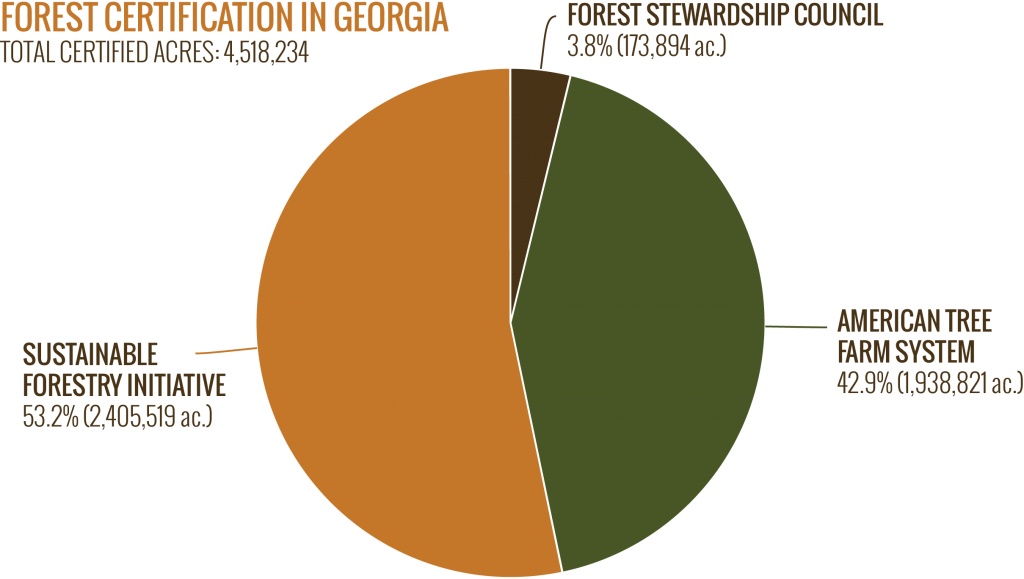The U.S. Green Building Council (USGBC), the governing body for the Leadership in Energy and Environmental Design (LEED) green building rating system, recently announced a pilot Alternative Compliance Path (ACP) which could eventually provide a market opportunity for well-managed, Georgia grown forests.
Of most importance to Georgia forest products, the pilot ACP provides a pathway for green building projects to use wood and paper from land certified by the Sustainable Forestry Initiative (SFI), American Tree Farm System (ATFS) or the Forest Stewardship Council (FSC). This is a very important step forward for Georgia woodland owners as the predominant forest certification systems used in the state are SFI and ATFS. Prior to the pilot ACP, LEED only gave recognition to FSC certified wood, of which there is very little in Georgia.
“We applaud the U.S. Green Building Council for taking this step forward to create more opportunities for Georgia grown wood in LEED certified buildings by recognizing the stewardship of our private forest landowners,” GFA President and CEO Andres Villegas said.
The ACP pilot program is part of an integrated approach by USGBC to encourage environmentally responsible forest management and to eliminate illegal wood from the building material’s supply chain. In order to count towards a LEED point using the pilot ACP, the user must prove that:
- 100 percent of the forest products used are from legal (or non-controversial) sources;
- 70 percent are from responsible sources, and;
- the remainder must be certified sources as evidenced by a chain of custody certification.
GFA is working together with partner organizations, forest product manufacturers and forest owners to determine whether or not Georgia grown wood will in fact be eligible to be recognized. The pilot ACP is not an official part of any LEED standard. In order for the pathway to become part of the standard, USGBC will hold a public comment period and its members will need to approve the pathway via vote.
Positive Change through Political Advocacy
Over the past ten years, hundreds of forest advocates, forestry organizations, state legislators and Governors have worked together to urge USGBC to change its LEED rating system to better recognize wood, especially wood from ATFS and SFI certified lands.
In 2012, Governor Nathan Deal issued an Executive Order prohibiting the use of green building standards in state buildings that do not give equal credit to wood products certified to any of several forest certification standards. In 2015, the Georgia General Assembly passed House Bill 255, requiring that state buildings built to green building standards give equal consideration to all forest certification programs.
While this change is certainly a positive step forward for forest landowners and forest product manufacturers, the Association’s work in advocating on behalf of the forest industry in LEED is not over. The Association will continue to work to ensure equal recognition of all forest certification systems under LEED and to promote the use of Georgia grown wood in buildings paid for by Georgia taxpayers.
Why Wood?
The economic, environmental and social benefits of Georgia’s sustainably grown and harvested timber is clear. Georgia’s working forests: contribute $28.9 billion to our state’s economy annually; provide $37.6 billion in vital ecosystem services including cleaning our air and water; support more than 130,000 jobs; and, offer unparalleled recreation activities.
Products from responsibly managed forests are also important to architects and builders focused on sustainable solutions that can transform the construction sector. Wood is an increasingly popular choice for construction because of its aesthetic qualities, and numerous environmental benefits — including renewability and a lower carbon footprint than other materials. Because trees absorb carbon dioxide from the atmosphere as they grow, they sequester and store carbon, reducing greenhouse gases, improving air quality and reducing the construction sector’s contribution to global climate change.
Georgia’s forests provide direct environmental benefits due to sustainable forestry management by Georgia’s landowners, logging contractors and wood product manufacturers. In fact, Georgia’s 24 million acres of forestland have remained stable for the past 50 years with forest growth exceeding removals by 41 percent annually. In addition, an estimated 90 percent of Georgia’s commercial forest acreage is in compliance with Best Management Practices (BMPs), which are voluntary guidelines that ensure water and soil quality are protected during forestry operations.


